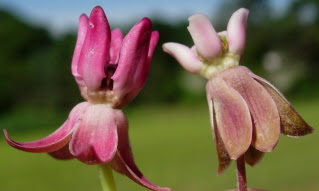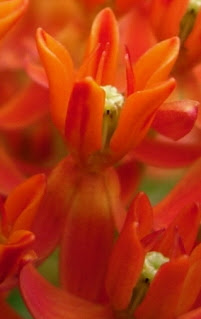Asclepias (Milkweed) Views - part #1

I like the members of the genus Asclepias (the Milkweeds) very much. They have numerous things going for them from my point of view: Their flowers are beautiful and fascinating, they are the food source for Monarch Butterfly caterpillars and they and many butterflies and other insects find them to be a major source of nectar, many milkweeds are showy in flower and easy to grow, releasing the seeds to the wind is fun, and finally they are distinctive and fairly easy to identify to species!
The following are some pictures I have taken here in
The first two grow in similar habitats, like old fields and roadsides, often side by side. They are done blooming for this year but can still be easily by their seed pods. A. syriaca ihas warty pods and A. purpurascens has smooth pods.
Asclepias syriaca (Common Milkweed) Flower umbels held below the leaves, washed out pinkish-purple flowers, the hoods smaller than A. purpurascens and warty green seed pods
Asclepias purpurascens (Purple Milkweed) Flower umbels held above the leaves and the large rich purple-red flowers have hoods longer than in common milkweed and smooth green seed pods. This species is much less common in our area than A. syriaca. I understand there are exactly two patches (a single clone in each) of this species in

Comparison of Asclepias purpurascens and A. syriaca flowers
Asclepias tuberosa (Butterfly weed, Orange milkweed)  This common and long blooming favorite of butterflies is in full bloom right now and will go on for a month or more. This species is commonly has bright orange flowers but yellow-orange individuals are not too rare. We have red-striped plants here in our garden that we have raised from seed of a plant that had a red stripe on the outside of each petal/hood. One of our 3rd generation plants we has pure red flowers! Check it out!
This common and long blooming favorite of butterflies is in full bloom right now and will go on for a month or more. This species is commonly has bright orange flowers but yellow-orange individuals are not too rare. We have red-striped plants here in our garden that we have raised from seed of a plant that had a red stripe on the outside of each petal/hood. One of our 3rd generation plants we has pure red flowers! Check it out!

Part #2 of the post will follow soon with Aa. exaltata, incarnata, viridis and verticillata.
I am always interested in seeing new species of milkweed!














Comments